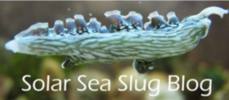

Ramping Up
It is time to get the system up to full capacity. The last component, a half-height 10-gallon tank (yes, that’s really a 5-gallon tank for the mathematically inclined) is now in operation. Originally designed to be a nursery, it seemed better suited to use as a Bryopsis culturing tank. I have been pleased with growth rates under the Evergrow S2 hydropnics light, so I picked up another one from Exotic Reef Creations. So there are now two slug tanks and two algae tanks for the upcoming project. With the red light from the hydroponics lights and the green from the algae, one might be tempted to think it looks a little like Christmas around here.
Here’s a better view of the new algae tank, with eggcrate to acts as a substrate and a small Hydor propeller pump to provide current. Several of the original samples of Bryopsis had started growing in fellow aquarists coral propagation systems, and were provided conveniently mounted on “frag plugs” onto which fragments of coral colonies are normally glued to enable them to grow. In this case, the growth of the algae on the plugs allowed easy and stable placement in the eggcrate.
There have been a few other improvements as well. In November, I got the new Neptune Systems Apex controller hooked up. Although it is capable of much more, it is hooked up to monitor and log energy use, system pH, water temperature, air temperature (in case of failure of environmental controls in the building), and moisture on the floor. The unit controls all of the lights, pumps, chiller, and heater, and can, for example shut down the pumps automatically in case of a spill being detected. Further, the system is completely accessible through a cloud-based interface, which allows control while I am away from the office.
Along with keeping an eye on the system when I am away, the Apex provides a log of some parameters. For example, when all of the lights were on at the same time of day, pH fluctuated significantly. The upper plot in the graph show detail of pH rising from 8.1 in the early morning to 8.5 when the lights went out at the end of the day. Because CO2, which reduces pH through the formation of carbonic acid, is consumed during photosynthesis when the lights are on and builds up at night, it is not surprising that pH steadily rises during the day.
Although it did not seem to cause the plants or animals much stress, it seemed worth trying to reduce the fluctuation. Rather than having all lights on at the same time of day, I set the lights on the algae growth tank to be on during the night. In this way, photosynthesis would be relatively constant in the system over the course of the day, with the potential benefits of stabilizing pH and keeping consumption of nutrients relatively steady. I was pleasantly surprised to see the pH fluctuation reduced to between 8.25 and 8.35. Frankly, the livestock did not seem as excited as I was.
Finally, I added a small protein skimmer (a.k.a., foam fractionator) to remove microalgae and organic material from the water column. Some might argue that suspended material serves as a source of nutrients for the plants, but in my experience desirable algae and plants tend to outcompete nuisance algae when a skimmer is used. None of the the nutrients provided by the dosing system are removed by skimming, so the skimmer just removes the compounds that are not under my control. With the height restrictions of the sump, I went with a Reef Octopus BH50, which is designed for small systems. It has been easy to set up and adjust, and extracts significant amounts of smelly material every day.
For the next few weeks, we’ll be watching algae grow. After the holidays, it will be time to order up a batch of slugs for the next round of Slug Science!






Recent Comments